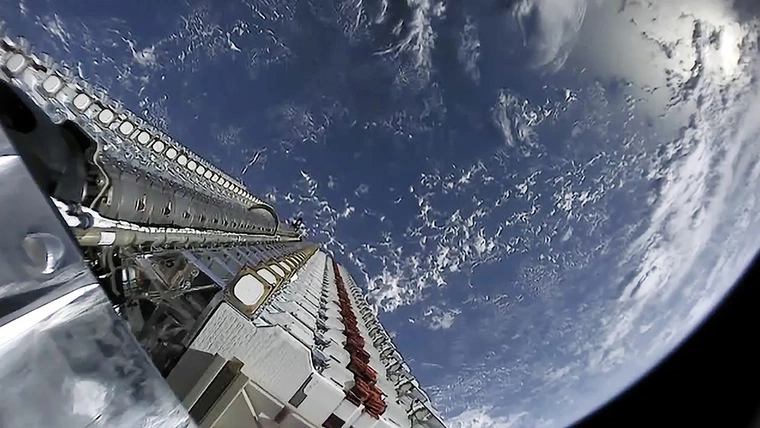New research reveals that under certain conditions, SpaceX’s Starlink satellites can produce “extreme flaring,” making them appear exceedingly bright and creating unnecessary aviation risk and confusion for observers on the ground.
These findings, detailed in a preprint paper published on arXiv, suggest that the dazzling reflections produced by Starlinks can confuse airline pilots, leading to increased reports of unidentified aerial phenomena (UAPs).
“This study demonstrated that Starlinks can be exceedingly bright under certain conditions,” Anthony Mallama, a researcher at the IAU Centre for the Protection of Dark and Quiet Skies from Satellite Constellation Interference and one of the authors of the study, to Universe Today. “In one instance, they were reported as Unidentified Aerial Phenomena by pilots on two commercial aircraft.”
First launched in 2019, Starlink is a part of SpaceX’s ambitious project to provide global high-speed internet coverage, mainly targeting remote and underserved areas.
The current V2 Starlink satellites consist of 22-foot-long flat panels equipped with multiple high-throughput antennas and a single solar panel for power. While in orbit, the satellites communicate with each other and designated ground stations, forming a massive satellite constellation.
As of April 2024, over 5,800 Starlink satellites were in orbit, with thousands more planned to be launched in the coming years, making it one of the largest satellite constellations ever deployed.
Its low Earth orbit (LEO) configuration sets Starlink apart from traditional satellites. These satellite constellations typically orbit at altitudes between 200 miles and 745 miles.
This proximity to Earth allows for lower latency and faster internet speeds than geostationary satellites. However, this low altitude and the sheer number of satellites also means that they are frequently visible from the ground, appearing like a string of bright dots moving across the night sky, often referred to as a “Starlink train.”
The brightness of Starlink satellites, as observed from Earth, can dramatically surge when sunlight reflects off their flat solar arrays. This reflection, known as flaring, happens when the angle between the satellite, the observer, and the Sun aligns perfectly.
Under certain conditions, Starlink satellites can produce “extreme flaring,” reflecting a luminosity that is magnitudes brighter than anything typically seen in the night sky.
To investigate these instances of extreme flaring, researchers Anthony Mallama and Dr. Richard E. Cole conducted a detailed geometric analysis of the satellites’ reflectivity and empirically measured their brightness under various conditions.
Researchers focused on the relationship between the satellite’s brightness and the off-specular angle, which is the angle between the specularly reflected sunlight and the observer’s line of sight. This empirical approach allowed them to validate their findings and better understand the conditions leading to such bright flares.
By analyzing the visual magnitudes of the flares and comparing these with bidirectional reflectance distribution functions (BRDF), a mathematical function that describes how the surface of a satellite reflects light in different directions, findings showed that extreme flaring occurs whenever sunlight hits the flat, downward-facing portion of the satellite’s chassis at a glancing angle.
The phenomenon is pronounced when the satellite is near the horizon and the Sun is just below the horizon, creating the optimal conditions for these intense reflections.
Researchers used these findings to examine an incident that occurred on August 10, 2022, where multiple commercial airline pilots flying over the Pacific Ocean reported seeing unidentified aerial phenomena (UAP) resembling high-altitude bright lights appearing to move in a circular pattern.
The incident was one of several similar UAP sightings reported by commercial pilots over nearly two months in the fall of 2022, first reported by paranormal researcher and television personality Ben Hansen on social media and his YouTube channel.
In an empirical study presented at the 4th IAA Conference on Space Situational Awareness in March 2024, a team of researchers used two-line element (TLE) data, Automatic Dependent Surveillance-Broadcast (ADS-B) data, and visualization simulations to conclusively determine that the unusual aerial objects observed by pilots on August 10, 2022, were a closely spaced train of Starlink satellites from launch 4-26.
Expanding on these findings, Mallama and Dr. Cole concluded that the unusual observations made by pilots were also instances of extreme flaring.
Based on the timing and position of the eyewitnesses, the Starlink satellite train was near the horizon and close to the solar azimuth. At the same time, the Sun was 30 degrees below the horizon. Additionally, some of the pilots reporting the UAP incident were flying at an angle directly in the path of the light beam being reflected off the satellite’s solar array.
This unique set of geometric conditions resulted in the Starlink satellites producing extreme flares, appearing to eyewitnesses at an apparent magnitude of -5 or -6. To put this into perspective, Venus, the brightest planet in our night sky, shines at around magnitude -5 when observed from Earth.
“In summary, specular reflection from the nadir side of the Starlink spacecrafts’ chassis can account for the brightness recorded by the pilots,” wrote researchers. “This finding supports the conclusion that the Unidentified Aerial Phenomena were actually Starlink satellites.”
The August 2022 incident detailed in the study underscores the potential aviation safety concerns by illustrating how startling and disruptive extreme flares can be. With Starlink satellites reflecting sunlight at such high brightness levels, pilots could be misled into thinking they are witnessing unidentified or threatening objects.
There are some potential solutions to mitigate these extreme flares by LEO satellites like Starlink. This includes designing satellites to reflect sunlight into space rather than toward the ground. This method has shown promise but isn’t foolproof.
“One approach to reducing satellite brightness is to reflect sunlight into space rather than allowing it to scatter diffusively toward observers on the ground,” Mallama explained to Universe Today. “That works very well most of the time. However, there are certain sun-satellite-observer geometries where it fails, and observers see a mirror-like reflection of the Sun.”
SpaceX has been trying to address these concerns with newer generations of Starlink satellites. The second-generation satellites are designed to be less reflective, but as Mallama and Dr. Cole’s research shows, certain conditions can still lead to extreme flares.
In their paper presented at the March IAA Conference on Space Situational Awareness, researchers noted that the lack of awareness of extreme satellite flaring also complicates efforts to track and report actual UAP incidents.
“The once reluctant scientific community is slowly starting to consider the underlying causes of UAP reports as an interesting area for research, with global reach,” researchers wrote. “However, we lack sufficiently mature tools and methods to systematically analyze sighting reports for even the ‘known phenomena’ category.”
“Without such critical methodologies in place, satellites, rockets, and drones will continue to clutter pilot communication channels and aviation hazard databases as these knowable lights in the sky are reported as UAP.”
Tim McMillan is a retired law enforcement executive, investigative reporter and co-founder of The Debrief. His writing typically focuses on defense, national security, the Intelligence Community and topics related to psychology. You can follow Tim on Twitter: @LtTimMcMillan. Tim can be reached by email: tim@thedebrief.org or through encrypted email: LtTimMcMillan@protonmail.com

